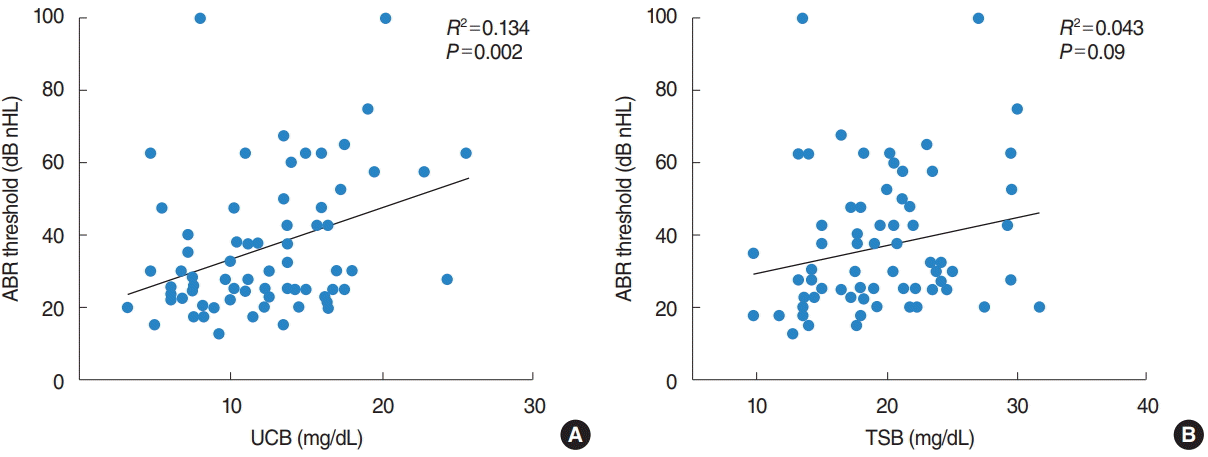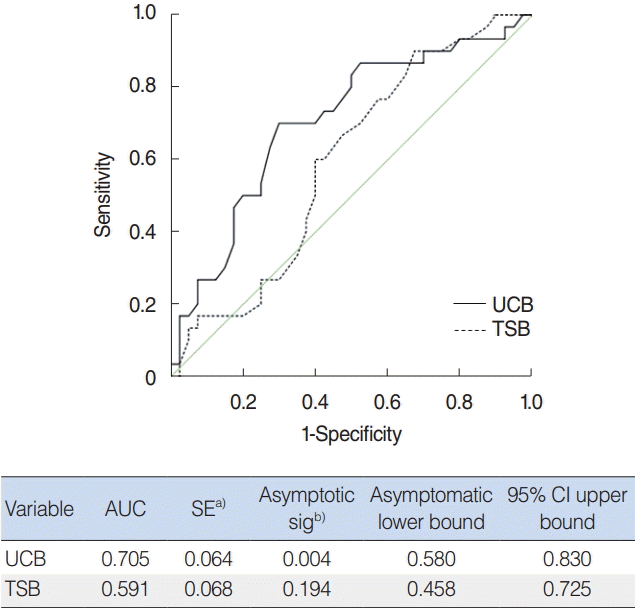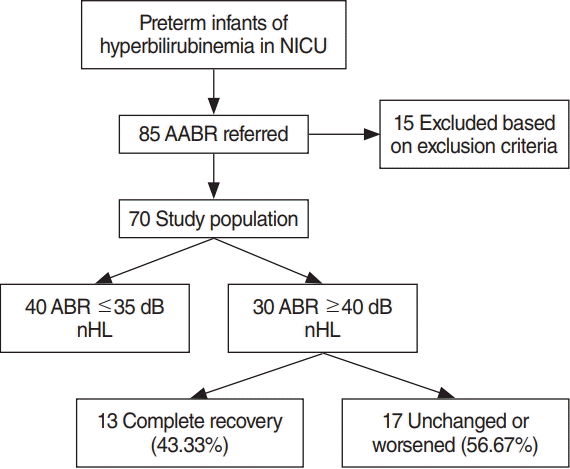INTRODUCTION
Hyperbilirubinemia in infants is the major leading cause of neonatal intensive care unit (NICU) treatment and is known to be an important risk factor for neonatal hearing loss. In preterm infants, the clinical significance of relationship between hyperbilirubinemia and hearing loss is well reported [
1,
2]. It is also known that the auditory pathway is one of the most vulnerable area of the central nervous system for bilirubin neurotoxicity. However, the correlation between bilirubin levels and hearing outcome is still unclear. This is because bilirubin exposure cannot be accurately quantified, and auditory toxicity after exposure is also quite variable, ranging from subtle to complete hearing loss [
3]. Up to 80% of preterm infants in NICU have a hyperbilirubinemia, which often present as jaundice due to bilirubin deposition. Total serum bilirubin (TSB) concentration >25 mg/dL or above is used to determine whether phototherapy and transfusion are needed, but it has been reported that high levels of free unconjugated bilirubin (UCB) causes neuronal toxicity through the blood-brain barrier [
4,
5]. Bilirubin is a type of neurotoxic substance that inhibits mitochondrial enzymes and DNA synthesis, which blocks excitatory signaling of the nerves. Although bilirubin has been reported to damage cochlear nuclei and accumulation bilirubin in the auditory pathway, the mechanism of bilirubin-induced hearing loss has not been clearly established [
6]. In preterm infants, precise relation between bilirubin levels and hearing threshold, including newborn hearing screening and diagnostic auditory brainstem response (ABR) is largely unknown. The purpose of this study is to evaluate the effect of hyperbilirubinemia on hearing threshold and auditory pathway in preterm infants by serial ABR. In addition, we evaluated the usefulness of the UCB concentration as compared with TSB in predicting bilirubin-induced hearing loss in preterm infants.
Go to :

RESULTS
During the study period, 85 infants who suffered from hyperbilirubinemia did not pass the newborn hearing screening and performed diagnostic ABR. Fifteen were excluded based on predefined exclusion criteria. A total 70 infants were enrolled. Flow diagram with included infants and hearing characteristics is given in
Fig. 1. Of these 70 infants, 40 were identified as normal hearing (≤35 dB nHL) and 30 were identified as abnormal hearing (≥40 dB nHL) in the diagnostic ABR. The follow-up ABR performed within 3–6 months showed complete recovery (≤35 dB nHL) in 13 (43.33%), unchanged or worsened in 17 (56.67%) (
Fig. 1). Of these 17, eight performed additional follow-up ABR within 12 months, two were recovered to normal hearing.
The clinical characteristics, risk factors of study population are given in
Table 1. The mean gestational age and birthweight for the preterm infants were 31.4±4.4 weeks and 1,552.1±794.8 g, respectively. The infants of the diagnostic ABR ≤35 dB nHL and ABR ≥40 dB nHL group were no significant difference in gestational age (
P=0.337), birth weight (
P=0.572) and other risk factor (
Table 1).
Table 1.
Clinical characteristics, risk factors of hyperbilirubinemic preterm infants <37 weeks of gestational age stratified by diagnostic ABR thresholds
|
Characteristics |
Total (n=70) |
ABR ≤35 dB nHL (n=40) |
ABR ≥40 dB nHL (n=30) |
|
Gestational age (wk) |
31.4±4.4 |
31.0±4.5 |
32.0±4.2 |
|
Birth weight (g) |
1,552.1±794.8 |
1,596.2±870.6 |
1,495.2±694.6 |
|
Male:female |
41:29 |
23:17 |
18:12 |
|
C-sec |
54 (77.1) |
30 (75) |
24 (80) |
|
Apgar score <5 |
8 (11.4) |
3 (7.5) |
5 (16.7) |
|
Sepsis |
25 (35.7) |
15 (37.5) |
10 (33.3) |
|
PCO2 >60 torr |
4 (5.7) |
2 (5) |
2 (6.7) |
|
pH <7.25 |
9 (12.9) |
5 (12.5) |
4 (13.3) |
|
PO2 <45 torr |
0 |
0 |
0 |
|
IVH >II |
0 |
0 |
0 |
|
Threshold of diagnostic ABR (dB nHL) |
42.3±23.3 |
25.6±5.8 |
64.5±18.9 |

As shown in
Table 2, preterm infants of ABR ≥40 dB nHL group showed significant differences in initial measured and maximal measured UCB concentration (
P=0.031 and
P=0.003, respectively) compared with ABR ≤35 dB nHL group. No difference was observed in the TSB concentration at initial measured and maximal measured concentration (
Table 2).
Table 2.
Comparison of bilirubin concentration between ABR ≤35 dB nHL and ≥40 dB nHL groups
|
Variable |
Total |
ABR ≤35 dB nHL (n=40) |
ABR ≥40 dB nHL (n=30) |
P-value |
|
TSB (mg/dL) |
|
|
|
|
|
Initial measured |
10.9±3.3 |
10.9±3.3 |
11.0±3.4 |
0.818 |
|
Maximal measured |
19.6±5.1 |
18.8±5.3 |
20.6±4.8 |
0.138 |
|
UCB (mg/dL) |
|
|
|
|
|
Initial measured |
10.6±5.1 |
9.5±4.6 |
12.1±5.4 |
0.031 |
|
Maximal measured |
12.5±4.8 |
11.1±4.5 |
14.4±4.7 |
0.003 |

Maximal concentration of TSB and diagnostic ABR thresholds were positive correlated but not statistically significant (
R2=0.043,
P=0.09), while maximal UCB concentration and ABR thresholds were statistically significant (
R2=0.134,
P=0.002) (
Fig. 2).
 | Fig. 2.Correlation between bilirubin concentration and diagnostic auditory brainstem response (ABR) threshold. (A) Relationship between unconjugated bilirubin (UCB) and ABR threshold. (B) Relationship between total serum bilirubin (TSB) and ABR threshold. 
|
We plotted the ROC curves to compare TSB and UCB as a predictor of hearing loss, defined ≥40 dB nHL in diagnostic ABR (
Fig. 3). Area under the curves of TSB and UCB were 0.591 and 0.705, respectively. UCB is a more sensitive and specific predictor of hearing loss indicating that a UCB level of 13 mg/dL provided the best sensitivity (70%) and specificity (70%).
 | Fig. 3.Receiver operating characteristic curves predicting the risk of hearing loss according to bilirubin level. UCB, unconjugated bilirubin; TSB, total serum bilirubin; AUC, area under the curve; SE, standard error; sig, significance; CI, confidence interval. a)Under the nonparametric assumption. b)Null hypothesis: true area, 0.5. 
|
Infants who had a threshold of 40 dB nHL or more in diagnostic ABR were divided into two groups according to follow-up ABR results, complete recovered group (≤35 dB nHL, n=13) and non-recovered group (≥40 dB nHL, n=17). As shown in
Table 3, in complete recovered group, follow-up ABR threshold was improved by about 30 dB nHL. However, there was no significant differences in wave V latency between two groups, and there was also no significant difference in bilirubin concentration (
Table 3).
Table 3.
Comparison of follow-up hearing results and bilirubin concentration between complete recovered and non-recovered group
|
Variable |
Complete recovered (n=13)
|
Non-recovered (n=17)
|
P-value |
|
Initial |
Follow-up |
Initial |
Follow-up |
|
ABR |
|
|
|
|
- |
|
Threshold (dB nHL) |
50.2±19.1 |
20.4±5.8 |
57.4±24.6 |
56.3±26.2 |
|
|
Wave V latency (ms) |
7.3±0.7 |
6.7±0.4 |
7.2±0.6 |
6.6±0.4 |
|
|
TSB (mg/dL) |
|
|
|
|
|
|
Initial measured |
12.0±2.9 |
10.3±3.7 |
0.231 |
|
Maximal measured |
20.2±4.2 |
20.9±5.3 |
0.182 |
|
UCB (mg/dL) |
|
|
|
|
|
|
Initial measured |
11.3±5.3 |
12.7±5.5 |
0.105 |
|
Maximal measured |
14.0±4.3 |
14.8±5.1 |
0.474 |

Go to :

DISCUSSION
Hyperbilirubinemia is one of the most common neonatal diseases that requires admission in the NICU. Severe hyperbilirubinemia in infants can cause a life-long debilitating disorder, therefore, early identification of at-risk infants during the neonatal period is crucial to promote the long-term outcome [
8]. This retrospective study showed hearing results of the preterm infants of hyperbilirubinemia by serial ARB and relationship between hearing status and UCB compared with TSB. TSB concentration was considered to be a biochemical marker used for the determining the treatment, such as blood exchange transfusion or phototherapy. Many prospective studies have demonstrated association between TSB concentration and bilirubin-induced neuronal damage although there is substantial evidence that TSB concentration is a poor predictor of neuronal toxicity including hearing loss and auditory neuropathy spectrum disorder (ANSD) [
9-
11]. Otherwise, there is a growing evidence that free UCB concentration is a better indicator of auditory system damage [
1,
12,
13]. Free UCB, the fraction of UCB not bound to albumin can cross the blood-brain barrier and cause neuronal damages including hearing loss. Since there is no way to measure free UCB directly in our institution, we conducted this study with only UCB concentration. While free UCB is a more sensitive marker of bilirubin-induced neuronal damage, UCB is an another sensitive marker because TSB and UCB concentration correlate well with free UCB [
12,
14].
In this study, we found that UCB concentration were significantly increased in infants with abnormal findings in diagnostic ABR (≥40 dB nHL) than in TSB concentration. In addition, direct correlation was found between the UCB concentration and the hearing threshold confirmed by ABR. Moreover, a significant relationship was founded between UCB level and hearing loss, which defined threshold ≥40 nHL in diagnostic ABR. In ROC curves, UCB level above 13 mg/dL provide best sensitivity and specificity (
Fig. 3). These results of our study and several others suggest that UCB in preterm infants related with hyperbilirubinemia is a better predictor of bilirubin-induced hearing loss as indicated by diagnostic ABR. The degree of hearing loss confirmed by diagnostic ABR is likely to be associated with UCB concentration. This was corroborated by Ahlfors and Parker [
1] who reported that free UCB concentration was better predictor than TSB concentration of failed UNHS, as evaluated AABR in a retrospective study. However, compared with our study, the subject consisted of infants over 34 weeks of gestational age, not limited to preterm who were not confirmed hearing loss by diagnostic ABR. Similar to our study, in a prospective study of preterm infants, free UCB concentration was found to be more sensitive and specific predictor than TSB of abnormal ABR waveform change, but they did not identify the threshold change with follow-up ABR [
12].
Bilirubin is a kind of neurotoxic substance that changes in energy metabolism, alteration in membrane function, decreased membrane potential, alteration in enzyme function, and inhibition of protein and DNA synthesis [
15,
16]. Although correlation between hearing loss and bilirubin-induced neuronal damage has been studied for a long time, type and sited of lesion are not exactly known [
6]. It appears that
in vitro study immature cells are more susceptible to bilirubin toxicity than differentiated cells, may also support a clinical experience that preterm infants are more susceptible to bilirubin-induced neuronal damage [
17]. Bilirubin has been reported damage to cochlear nuclei and auditory pathway through cochlear nerve, and the cochlear itself is often normal [
6]. Thus, hyperbilirubinemia often causes ANSD [
18], which defined by abnormal ABR finding in the presence of normal optoacoustic emissions (OAE). Rance [
19] reported that more than 50% of children with ANSD have a history of hyperbilirubinemia in the neonatal period. Similarly, Saluja et al. [
18] found that, of the infants with hyperbilirubinemia requiring exchange transfusion, 46% had abnormal ABR wave consistent with ANSD. Although hyperbilirubinemia is commonly associated with ANSD, we did not routinely perform OAE in all cases. Eight of the 17 infants with abnormal findings in follow-up ABR performed OAE, and one infant was diagnosed with ANSD. We will continue to follow up these patients to confirm additional ANSD while performing proper auditory rehabilitation.
Congenital hearing loss should be detected within 3 months and early intervention such as hearing aids within 6 months is essential for auditory development [
20]. Although UNHS has become widely used, maintaining sensitivity and specificity for appropriate screening result is still a difficult theme to consider. Neonatal otitis media with effusion is one of the significant cause of failed newborn hearing screening with reported rated 21% [
21]. It can prove to be very challenging to confirm OME by pneumatic otoscope and tympanometry in neonate, even by experienced examiner. Therefore, some infants who have recovered to normal hearing in follow-up ABR are likely to have OME, and may have affect the outcome of our study.
ABR is most commonly used modality to investigate bilirubin-induced neuronal damage in neonates and preterm infants, which as a direct, noninvasive assessment. Several studies have demonstrated reversible changes in ABR wave latency. However, at the infant’s periods wave I and III are not always detectable and therefore sequential measurements of latencies are not always possible [
22]. In this study, only wave V was detectable in most cases, so wave V was used for analysis. In complete recovered group and non-recovered group, the wave V latency tended to be shorter on follow-up ABR, but, there were no significant differences between the two groups.
There is much interest in the potential reversibility of bilirubin-induced hearing loss and there is growing evidence for the reversibility of ABR abnormalities in animal models [
12,
23]. Mild ABR abnormalities in infants with hyperbilirubinemia may reverse with intervention by phototherapy and exchange blood transfusion. Nakamura et al. [
24] found that prolonged ABR wave I and V latency resolved after exchange transfusion in a prospective study of infant with TB levels >15 mg/dL. It has been suggested that diagnostic ABR is sensitive to the earliest manifestations of neuronal damage, and treatment of hyperbilirubinemia by lowering TSB concentration at the time of abnormal ABR may reduce neuronal damage, but there have been no controlled trials to confirm this finding [
25]. Hearing loss caused by hyperbilirubinemia had a recovery rate close to 80% in normal infants [
22], while it was less resilient than expected in premature infants of this study. In our study, we also observed that 13 of 30 infants (43.33%) with abnormal finding at diagnostic ABR recovered to normal hearing in follow-up test within 6 to 9 months. Of the 17 infants with abnormal finding at follow-up ABR, 12 were able to follow-up continuously more than 1 year. Additionally, two infants recovered to normal hearing within follow-up periods, and as a result, 15 infants (50%) with abnormal results at diagnostic ABR were recovered eventually. Therefore, we recommend that infants should be evaluated through sequential ABR more than 1 year even if they have abnormal findings on diagnostic to follow up ABR. We constantly follow up non-recovered group with hearing aids and proper rehabilitation. Hearing loss caused by hyperbilirubinemia is found to be reversible but follow-up ABR test can also show permanent hearing loss, therefore it is necessary to accurately diagnose the bilirubin-induced hearing loss by sequential ABR test. In particular, it is considered necessary to provide a more careful counseling in cases of bilirubin-induced hearing loss in preterm infants.
We acknowledge a few other limitations. First, we could not control effectively various factors related to hearing loss due to characteristics of premature infants and could not include normal control group. Secondly, we could not perform initial and followup otoacoustic emission routinely, so the possibility of ANSD cannot be excluded. Thirdly, the retrospective character of this relative small study and concomitant selection bias is insufficient to draw conclusions. Long-term implications require additional investigation.
Despite these limitations, this is the first study to report on evaluation of relationship between hearing status and bilirubin concentration through the AABR, diagnostic ABR to follow up ABR. Our study demonstrates that UCB concentration is a better predictor of bilirubin-induced hearing loss than TSB in preterm infants as evaluated by serial ABR. Serial ABR testing can be a useful, noninvasive methods to evaluate early reversible bilirubin-induced hearing loss in preterm infants.
Go to :






 PDF
PDF Citation
Citation Print
Print





 XML Download
XML Download